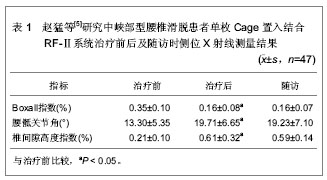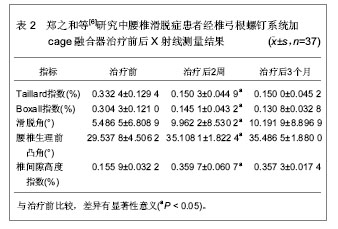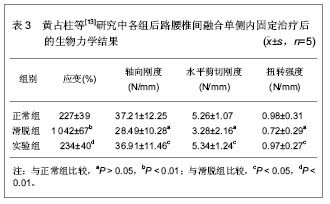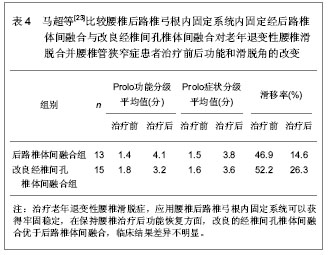2.1 腰椎滑脱后生物力学稳定性的变化 从生物力学的角度分析,腰椎稳定性的维持有两大要素,一是以三柱结构所形成的骨关节的静态性稳定装置,二是由腰椎旁相关肌群所产生的动态性稳定作用。
临床上绝大多数腰椎滑脱发生于L4-5或L5-S1,脊柱任一运动节段均存在剪切力,在腰骶部因椎间隙倾斜,剪切力尤为明显。因此,上一椎体对下一椎体有向前滑移、旋转的趋势。在生理载荷下,腰椎保持相互间的正常位置关系有赖于关节突关节、完整椎间盘的纤维环、周围韧带、背伸肌收缩力量和正常的脊柱力线。任何一种或数种抗剪切力机制的减弱或丧失均将导致腰骶部不稳,久之产生滑脱的病理过程。
正常人体重心位于腰骶关节前方,一旦发生滑脱,前置载荷重力力臂增加,将明显增加L5-S1间剪力,可加速椎间盘退变,导致小关节退变或关节囊韧带撕裂等。L5重度滑脱时,L5椎体后下方位于S1椎体前上方,纵向负荷长期应力集中于小范围区域,将使局部变形。典型表现为腰椎指数(腰椎后缘高/腰椎前缘高)减小,L5椎体楔形变,S1圆顶形改变,导致腰椎倾斜旋转加速,腰骶部后凸畸形加重。另外,由于L5对骶骨近端的压力,骶骨逐渐变得垂直,骶骨倾斜角变小。当患者站立时,由于腰椎过度前凸,易致L4反滑和骨盆屈曲性代偿,腘绳肌和髂腰肌紧张,加剧骨盆垂直,从而使L5-S1后凸畸形。有学者认为腰椎滑脱后矢状位稳定与治疗后腰椎前凸角和腰骶角有关,其纠正程度对判断预后有一定价值[1]。
L4-5是退行性腰椎滑脱的常见部位。随着年龄的增长,椎间盘的髓核水分吸收,纤维环松弛,间隙变窄,椎间不稳,小关节突退变,椎间盘的缓冲作用消失,下腰椎旋转轴由髓核移至椎间小关节,且站立位时腰椎前滑力增大,椎间活动增加,小关节突过度活动及所受的负荷增加,关节面重新塑形,关节间隙前移,其间小关节软骨剥离,软骨下骨裸露,使骨小梁顺应力的排列异常,L5上关节突后面磨损吸收致L4前滑,小关节突及关节面在异常旋转力作用下发生骨增生,关节突肥大,关节囊松弛,出现椎体的前移。在中立位时,尚可维持正常排列,但在过度屈伸时,可逐渐发生一定程度的前移及向后滑脱,严重者可以导致椎间孔的狭窄,压迫神经根,产生坐骨神经痛的现象。
2.2 腰椎滑脱症植入物内固定治疗恢复椎体的稳定性
2.2.1 坚强融合内固定 利用具有高弹性模量的钛合金等金属材料制作而成的内固定系统配合各种融合方法进行的脊椎内固定,植入物与椎体间是刚性连接。通常使用坚强内固定装置矫正畸形、稳定脊柱,骨融合率较高,减少了假关节形成。但越来越多的证据表明,其存在腰部活动受限,脊柱动力学改变和邻近节段加速退变等一系列并发症。目前,对如何减少坚强脊椎内固定所带来的负面效应探索较少,也无法避免这种效应。
2.2.2 动态融合内固定 也称为半坚强内固定。这种内固定系统分两种,一种是用较低弹性模量的金属或高分子材料制成;另一种仍是由高弹性模量的金属材质制作而成,但器械内部可以产生局部的微动。其主要目的是用弹性材质或微动装置分散坚强内固定负荷传导,减少应力遮挡效应及邻近节段的应力集中。目前,在临床应用的动态融合固定系统主要有LK韧带成形、动力螺钉固定装置、Twinttex动态固定系统、Crock-Yam-agishi(C-Y)固定系统等。
单枚Cage置入结合RF-Ⅱ系统治疗峡部型腰椎滑脱:赵猛等[5]研究单枚Cage置入结合RF-Ⅱ系统治疗峡部型腰椎滑脱,选取2007年7月至2010年12月收治的47例Ⅰ-Ⅲ度峡部型腰椎滑脱患者,对患者进行回顾性分析,治疗前后及随访时侧位X射线测量结果,见表1。

所有患者单枚Cage置入结合RF-Ⅱ系统治疗后滑脱有不同程度复位,椎间隙增高,滑脱角改善;随访12-60个月,平均30个月,矫正程度无丢失,cage无下陷、滑移,椎间隙高度无丢失,所有患者治疗后12-18个月均获骨性愈合。cage椎间融合器能使滑脱椎体间接复位,直接撑开椎体前中柱,恢复椎间隙高度,维持腰椎的生理弧度,提高融合率;RF-Ⅱ型椎弓根螺钉系统有直接复位滑脱椎体,两者结合能提供内在稳定和支撑作用,疗效满意,适用于峡部型腰椎滑脱症的治疗。
椎弓根螺钉系统加cage融合器治疗腰椎滑脱症:郑之和等[6]分析椎弓根螺钉系统加cage融合器治疗腰椎滑脱症,选取2003年2月至2006年3月收治的腰椎滑脱症患者37例,其中滑脱部位为L3的3例,L4的23例,L5的11例。Meyerding滑脱程度分级Ⅰ度滑脱12例,Ⅱ度滑脱20例,Ⅲ度滑脱5例。经椎弓根螺钉系统加cage融合器治疗前后Tailard指数、Boxall指数、腰椎生理前凸角、滑脱角及椎间隙高度比较,见表2。

患者治疗后评分,优27例,良8例,可2例,优良率在94.6%。治疗后3-8个月植骨均融合,平均3.9个月。经椎弓根螺钉系统加cage融合器治疗腰椎滑脱症,滑脱复位不容易丢失,能够恢复并保持正常脊柱结构及生物力学功能,是治疗腰椎滑脱症比较理想的方法之一。
2.2.3 动态非融合内固定 也称为弹性固定,是指在不融合的前提下改变腰椎的负荷传导和活动范围的一种固定方式。其设计的目的是能改变脊柱运动节段的负荷传递方式,阻止产生疼痛的运动方向和运动平面的脊柱运动,保持运动功能,预防邻近节段退变,使失稳的腰椎达到其正常状态的活动特性,实现动态重建腰椎序列。主要用于腰椎滑脱的动力内固定系统有Graf ligament系统、Dynesys系统、ISOBAR和ISOLOCK系统。近年来国内外均有大量的临床报道,其近期效果满意[7]。
2.2.4 峡部关节处直接修复 峡部关节缺损部位直接修复植骨,适用于青壮年有症状不伴有退行性椎间盘疾病的滑脱患者[8]。一般在6个月时出现骨性融合,同时可以早期促进正常腰椎活动。Ivanic等[9]利用钩螺钉对113例腰椎滑脱患者行峡部关节处直接修复,其方法是将钩子钩住L5或L4椎板处,在L5或L4上关节突下方为进钻点,进钻点与椎体终板水平方向向下成40°,且钻尾与后正中矢状面成20°进钻,再将螺钉旋入椎弓根固定。平均随访11年,发现小于14岁的患者融合率明显高于20岁以上的患者,进一步说明峡部关节处直接修复适合于年轻的滑脱患者。
2.2.5 L5椎体切除 Gaines等[10]报道将L5全切、L4与S1融合的患者,优点在于腰椎缩短后,易于使椎体矢状面平衡重排,也可减少神经损伤;同时,又对30例滑脱患者行峡部关节处直接修复,平均随访15年,未发生大小便异常,认为及早行峡部关节处直接修复可以取得良好的疗效。Wild等[11]报道运用峡部关节处直接修复技术治疗18个月龄幼儿的腰椎滑脱患者,随访10年,临床疗效良好,未见明显不良并发症。邹德威等[12]采用前路L5切除,后路RF系统复位固定治疗滑脱,取得良好效果。
2.3 腰椎滑脱症椎间融合治疗恢复椎体的稳定性 椎体融合是维持复位和椎体稳定性的重要环节。通过腰椎外科治疗技术可以提供椎体的早期稳定,但长期的稳定性需要坚强的生物性融合才能完成,其融合方法按植骨部位可以分为椎间融合、后外侧融合、椎体环周360°融合等,按是否使用器械可以分为非器械固定融合和器械固定融合;按治疗入路又可以分为前路椎间融合、后路椎间融合、经椎间孔椎间融合。
2.3.1 后路腰椎间融合恢复椎体稳定性 因椎体前中柱承受脊柱负荷的80%,而后方结构仅承受脊柱负荷的20%,椎体间融合会使腰椎获得更好的稳定性,椎体间较大的接触面提供理想的植骨床,Wolf定律认为压力下植骨块骨融合的潜力较大,从理论上支持椎间融合效果优于后外侧融合和椎体环周360°融合,而且后路腰椎间融合从单一入路即可完成各种角度植骨,减少手术时间和经腹的并发症,常用载有自体髂骨的椎间融合器如Cage、BAK等进行融合,但伴有植骨块脱出、骶骨骨折或神经血管损伤等并发症。
黄占柱等[13]分析腰椎滑脱后路腰椎间融合单侧内固定治疗后的稳定性。采用15具新鲜小牛脊柱标本,分为正常组、L5-S1滑脱的滑脱组、L5-S1滑脱使用后路腰椎间融合单侧内固定的实验组,制成L5-S1滑脱的腰椎失稳模型,将标本后路切除L5-S1间盘,植入Cage,即钛纤维加强型多聚体椎间融合器,内固定器械固定,实验前先反复预加载5次,加载速度6 mm/min,最大负荷25 N。轴向强度测试应用0-250 N负荷量程,加载速度25 mm/min。在前屈和后伸测试中,加载速度为25 mm/min,力矩为2.5 N/m[14]。在左右侧屈测试中,加载速度为25 mm/min,力矩为2.5 N/m。每具标本测试时间不超过3 h,测试各组的生物力学特性,其结果见表3。

采用后路腰椎间融合单侧内固定后,在轴向压缩、前屈、后伸、侧弯情况下,实验组平均轴向刚度、水平剪切刚度、扭转强度和扭转刚度均较滑脱组增加,其数值与正常组差异无显著性意义(
P > 0.05),与滑脱组差异有显著性意义(
P < 0.05)。采用后路腰椎间融合单侧内固定后能够达到腰椎生理正常状态,满足对固定后即刻稳定性的需要。
2.3.2 前路椎间融合恢复椎体稳定性 包括完全前路椎间盘切除及融合滑脱椎体,常规需用Cage进行融合,可分为传统的腹膜外切开入路及微创腹膜外入路。前路椎间融合与后路椎间融合的比较研究中,Verlooy等[15]认为要得到90%的优良临床疗效,后路内固定可能是最主要的环节;单独使用前路椎间融合或后路椎间融合的非器械融合不是治疗腰椎滑脱合适的外科方法。Satomi等[16]比较27例行前路椎间融合和14例行后路减压的患者,疗效满意率分别为77%和56%,在退变性腰椎滑脱的早期阶段行前路椎间融合,因椎管狭窄主要由于下关节突向前滑移,可通过撑开椎间隙间接复位。在腰椎滑脱晚期,下位椎体上关节突骨赘形成占据椎管容积,造成神经压迫,应行后路减压。椎间融合不仅可以提高融合潜力,还可以恢复椎间盘的高度,优化矢状面平衡,调整冠状面的排列[17-18]。
2.3.3 后外侧融合恢复椎体稳定性 后外侧融合是常见的治疗退变性腰椎滑脱的融合方式,要点为横突间及关节突关节间植骨。其操作简便,可同时行减压,植骨部位距腰椎屈曲活动轴较近,周围血运丰富,利于骨愈合。缺点为融合强度小。Tajima等[19]认为后外侧融合是传统脊柱融合方法,尽管在腰骶段经常发生融合失败,但是还是有较好的近期及远期效果。有学者认为椎间隙前方高度未丢失,无椎间盘突出,可以行后外侧融合。关于后路椎间融合和后外侧融合的研究,Madan等[20]比较研究后路内固定加后外侧融合以及后路椎间融合治疗轻度峡部性腰椎滑脱,研究发现虽然后路椎间融合的融合率较高以及维持复位效果较好,但后外侧融合的融合率和维持复位效果更佳;而且多数学者认为后外侧融合是治疗轻度峡部裂型腰椎滑脱的金标准。
此外,Kwon等[21]分析后认为环周360°融合的临床效果可能更佳。孟志斌等[22]研究三点稳定式脊柱融合治疗退行性腰椎间盘病变41例,其中有27例为腰椎滑脱患者。治疗后随访X射线测量椎间隙前部高度治疗前(8.05±0.35) mm,治疗后(11.44±2.33) mm,比较差异有显著性意义(P < 0.05);椎间隙后部高度治疗前(6.13±1.45) mm,治疗后(8.66±2.10) mm,比较差异有显著性意义(P < 0.01);椎体滑脱距离治疗前(8.68±2.33) mm,治疗后(1.92±2.37) mm,比较差异有显著性意义(P < 0.05)。三点稳定式脊柱融合治疗退行性腰椎滑脱具有符合脊柱的生理负重特点,只用一个后路切口同时完成前后路融合,植骨量小、损伤较小、临床疗效满意。
2.4 不同融合方法恢复腰椎滑脱后椎体稳定性 腰椎后路椎弓根内固定系统内固定经后路椎体间融合与改良经椎间孔椎体间融合的比较,马超等
[23]比较两种方法治疗老年退变性腰椎滑脱合并腰椎管狭窄症的稳定性和功能,选取28例患者分为经后路椎体间融合组13例和改良经椎间孔椎体间融合组15例。滑脱部位为L
5-S
1,滑脱度为Ⅱ-Ⅲ度,有侧隐窝狭窄和中央椎管狭窄。治疗前后Prolo功能和腰椎滑脱角的改变,见表4。
王晓明等
[24]比较椎弓根器械复位固定后不同融合法对腰椎滑脱症的疗效。Ⅱ度以内腰椎滑脱共48例,椎弓根器械复位固定后行后外侧融合组26例,椎弓根器械复位固定后行后侧椎体间融合组22例。对两组治疗前后滑脱矫正、滑脱节段椎间隙高度改变、滑脱节段前突角改变及骨融合进行对比。发现治疗后即刻X线影像学结果差异无显著性意义(
P > 0.05);随访1-5年滑脱矫正及滑脱节段椎间隙高度的维持上后侧椎体间融合组优于后外侧融合组(
P < 0.05),滑脱节段前突角组间差异无显著性意义(
P > 0.05),但两组间临床疗效及并发症发生率无显著差异(
P > 0.05),内固定失败率后外侧融合组高于后侧椎体间融合组。可见,椎弓根器械复位固定并后外侧融合与后侧椎体间融合都是治疗Ⅱ度以内腰椎滑脱的有效方法,后侧椎体间融合在对滑脱矫形的维持及结构的稳定上具有优越的力学性能,后外侧融合后期易出现矫正丢失及内固定失败,但临床疗效不受明显影响。




